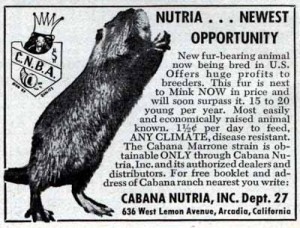History of Nutria in Florida
Florida and many parts of the American South have a long history of invasive plant and animal species. For instance, the spread of plants such as kudzu, water hyacinth and Brazilian pepper, and animal species such as zebra mussels, Asian carp, parrots, boa constrictors and certain rodents may begin innocently enough but wind up having serious environmental consequences.
Accidental or criminal introduction of non-native species that have no natural predators to control their numbers results in environmental havoc. As early as the 1600s, Spanish explorers brought pigs along as a handy food source. Quickly, these pigs escaped their pens and multiplied in the tropical climate. Even today, the descendants of those feral pigs roam the swamplands and bayous of Florida, Georgia and Louisiana, causing huge problems for farmers and the occasional innocent tourist.
So it is with the infamous nutria. Nutria are semi-aquatic mammals that resemble giant rats with webbed feet. They weigh up to 20 lbs. and measure up to 25 inches long. Nutria can produce up to three litters of four to six pups in a single year! They are voracious herbivores and consume great amounts of marsh grass and other aquatic vegetation, making them a perfect match for Florida’s swamps, wetlands, golf courses and back yards.
To understand why nutria are such a problem, let’s go back in time and examine how they became one of the most invasive animals ever to occupy the United States.
1890s – 1930s
The first nutria were imported from South America to California in 1899. Raised on farms, they quickly became an object of desire for fur farms as a cheap substitute for mink. By the 1930s, they had become a ranch animal in seven states, ranging from Oregon to New Mexico, Ohio and Louisiana. Unfortunately, cheap mink wasn’t appealing to many U.S. consumers and nutria fur was a slow sell.
1940s
After World War II, fur prices collapsed and nutria pelts were even less desirable. Many ranchers released their nutria populations rather than maintain them for lessening profit. At the same time, nutria became recognized as a “weed-cutter” species and were sold to an unsuspecting public for weed and vegetation control throughout the southeast and Florida. Hurricanes and floods dispersed nutria over wide distances, where they quickly established themselves and colonized thousands of acres of wetlands. Over this period, nutria turned vast areas of marsh into uninhabitable mud.
1950s – 1970s
By 1955, there were more than 20 million nutria chomping away in Louisiana and the nearby Florida Panhandle, wrecking levees, damaging dams and causing harmful erosion. Fortunately for Louisiana, more than 13 hurricanes made landfall in the next decades, eliminating many populations and dispersing others inland and to the east toward Florida. Their spread into Florida cattle ranches caused countless broken legs as heavy hooves sank into nutria burrows and runs. Regulatory protections on the animal were lifted, and nutria could then be trapped or shot as a nuisance. This put only a slight brake on population growth throughout the 1960s and 1970s.
1980s
A further decline in fur prices led to more releases and diminishing interest in trapping or hunting this invasive species. Nutria have no natural predators in North America other than humans, except the (also invasive) boa constrictor, Florida panthers and certain large raptors like hawks and eagles. Nutria trapping and hunting continued, aided only by the occasional freeze or flood as limiting factors on nutria damage in the Florida landscape.
1990s – 2000s
As wetland damage increased, the U.S. government began studies of nutria populations in the American South. Aerial surveys showed huge tracts of damage, centered in Louisiana. Further studies were commissioned but nutria population control methods remained largely ineffective. One program in Louisiana’s goal was the harvest of 400,000 nutria annually, with a small bounty for each pelt.
Nutria in Florida Today
Nutria populations range throughout central and Gulf Coast Florida, extending southward as far as Tampa, Sarasota and Venice. They cause small sinkholes in golf courses with their burrowing. They strip bark from fruit trees and clip off expensive plantings like lawn mowers. They disrupt wetland ecosystems, destroying vegetation and nutrients that mollusks and fish depend upon. Their burrowing habits weaken foundations and cause wharf, dock and pier damage. When their droppings contaminate water, they can transmit parasites to humans and livestock.
Nutria removal is difficult. They are clever animals, and extremely wary of humans. It is difficult for a homeowner or business owner to repel, trap or bait them safely and effectively. Like any rodent control, these measures are best left to a professional. Consult with us for your nutria removal, nutria trapping and nutria damage control needs.
Nutria removal serving Hillsborough, Pinellas, Pasco, Hernando, Sarasota, Manatee counties.
Also the communities of Brandon, Seffner, Riverview, Providence Lakes, Bloomingdale

